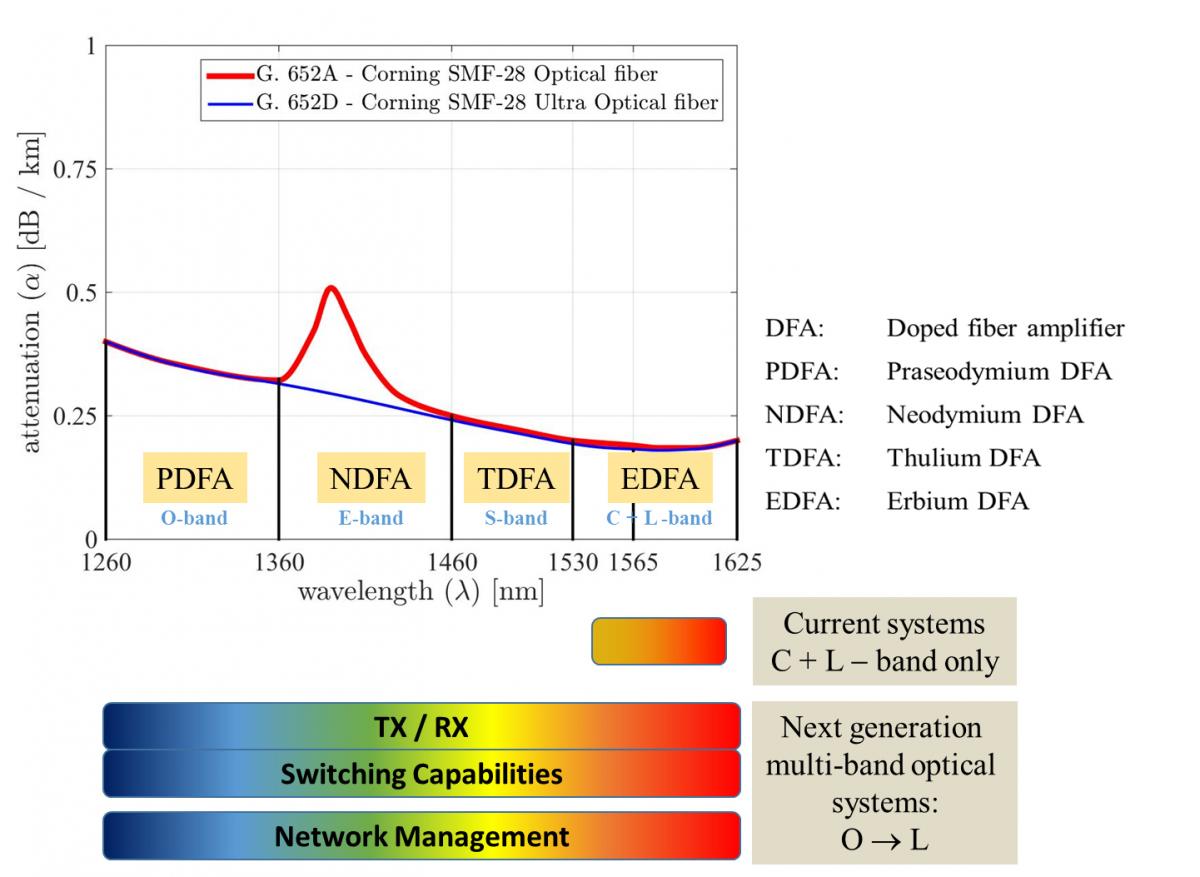Optical fibers and optical communication systems are the technologies that made possible the internet revolution and the global availability of high-capacity wireless communications (LTE, 4G, etc.). This fundamental global infrastructure is the result of enormous investments realized by telecommunication operators and governments over the last several decades and leverages the great properties of optical fiber as a transmission medium: large bandwidth, low attenuation, low cost, light weight, and immunity to the electromagnetic field.
Internet data traffic is continuously growing, boosted by never-ending innovation in web-based applications and technology such as ultra-high definition (4k/8k) video streaming, intensive cloud storage, and virtual/augmented reality, as well as the booming number of machine-to-machine (M2M) connections, which represent the foundation of the Internet of Everything (IoE). This trend can be quantified by the Compound Annual Growth Rate (CAGR), which at the moment is globally around 24%, but exceeds 40% in numerous regions [1]. The CAGR forecast may prove to be conservative, as the deployment of 1GE fixed access and 5G technologies will dramatically increase the capacity available to end-users. As these expectations materialize, there will undoubtedly be a significant impact on both metro and core networks [2], driving the need to light up the remaining available, if any, dark fibers. On the other hand, all of these systems would still operate on a limited spectrum, i.e., the C-band (from 1530 nm to 1565 nm) only. Given these facts, we believe that once the dark fiber resources are also exhausted, the most favorable economical solution would be to develop the required photonic components to extend the fiber bandwidth, rather than to immediately deploy new cables, and additionally light up several parallel fiber systems.
What is the Status of Optical Communication Infrastructure?
A large number of European citizens are already connected to broadband internet, and a considerable number of them can access the internet through optical fibers up to 1.5 miles from their homes. Approximately 90% of the deployed optical fibers in Europe are Standard Single Mode Fiber (SSMF), and a considerably large portion of them are made of ITU-T G.652D fiber, which is characterized by an almost negligible water peak (~0.3 dB/km @ ~1380 nm). This type of fiber has been extensively deployed since 2003 by all of the largest European operators with wide coverage in metro and long haul links. The G.652D fiber represents a significant part of European optical fiber infrastructure compared to conventional G.652 fibers (with water peak). At the moment, all installed systems exploit the C-band only, although the full available optical bandwidth, in a single mode fiber, ranges from 1260 nm (O-band) to 1625 nm (L-band), i.e., 365 nm or 10 times more than the C-band alone.
With the aim of efficiently and fully utilizing the available spectrum in the C-band, modern commercial transponders introduced flexibility by enabling transmission of different modulation formats and rates, thus allowing transmission optimization based on the current link requirements. This important feature was enabled, among others, by the introduction of advanced digital signal processing techniques and wavelength selective switches. State-of- the art transponders today achieve variable capacities up to 25 Tbps over metro and long haul distances. However, this might not be enough and as Andrew Lord, Head of Optical Research at BT said, “Traffic demand is beginning to stretch C-band fiber capacity limits. Spatial division multiplexing [SDM] based on future multi-core fibers is still a long way off becoming a robust, reliable replacement for SMF. Therefore, exploration and development of technologies for multi-band use [from the O- to L-band] especially in the metro environment would be highly welcome news and an exciting development for European operators.”
How Can We Increase the Capacity per Fiber?
Fundamentally, three solutions can increase optical system capacity to accommodate the growing demand:
- Lighting up the remaining dark fibers in currently deployed systems
- Installing new optical cables such as multi-core or multi-mode fibers (a long-term and costly investment)
- Modularly opening up the remaining transmission bands over dark fibers or fibers already in use, such that the fiber spectrum of a single mode fiber can be efficiently and cost effectively exploited
The first approach, when available, is the most straightforward one, but still C-band limited. The second option requires the installation of new systems and/or the deployment of new fibers, which results in significant costs as mentioned by Andrew Lord. A safer approach is represented by the third option. In this case, the investment would concern only the purchase of the components needed to open up, in a modular way, the required bands without deploying any further fibers. This would allow the operators to dynamically adapt their roadmaps to the actual requirements, thus minimizing the investment risk.
The optical capacity is directly related to the total available bandwidth. As previously mentioned, C-band only systems enable transmission over 35 nm, while the actual single mode bandwidth of an SMF is 365 nm. Until now, the unused part of the spectrum was not needed because the capacity delivered by commercial optical systems was sufficient. Nowadays, the scenario has changed: the requirements of more bandwidth and the traffic migrating from long haul to regional and metro distances make the available spectrum from 1260 nm to 1625 nm a highly valuable resource. Furthermore as discussed, European operators have made huge investments to deploy better performing fibers such as ITU-T G.652D. The properties of these fibers pave the way toward the possibility of transmitting over the whole wavelength range from 1260 nm to 1625 nm, which could lead to an astonishing 10x increase in the available bandwidth compared to C-band only systems. Additionally in the case of a metro segment, a large majority of links are not performance critical, for example in terms of OSNR. This grants a certain degree of flexibility in using lower performing wavelengths/bands for less demanding links, therefore freeing portions of the C-band when needed. Furthermore, as Juan Pedro Fernández-Palacios Giménez, Head of Unit at Telefonica Transport Technology and Planning, explains, “The attenuation of the ITU-T G.652D fiber is not a limiting factor anymore, and if the needed photonic components could be developed, together with an intelligent network management system, the transmission over this type of fiber would be possible also over the not yet used bands. Moreover, being a significant part of traffic growth in metro areas, where fiber spans are short, there is an opportunity to move beyond the C- or L-band fairly easily and efficiently.”
The Enabling Technologies
In order to exploit all available bands, novel systems and photonic technologies must be developed to realize the needed components for a commercially attractive solution working over the entire optical band. More precisely, the following devices must be developed:
- A coherent transceiver capable of covering the entire wavelength range
- A compact low cost amplification stage modularly covering all bands so that each band can be fully optimized (by properly selecting the best rare earth material) and provide a pay-as- you-grow upgrade strategy
- Wavelength switching elements for optical add/drop multiplexers, either capable of operating on the full band or with the same modularity of the amplification stages.
Finally, these devices will need a sophisticated software-defined network platform to dynamically and efficiently manage this huge bandwidth
The requirement for this technology can be graphically visualized in a possible working scenario. A next-generation multi-band optical system will exploit the bands from O to L, though eventually with different performance and classes of traffic. The following diagram displays the attenuation vs. wavelength for an exemplary of G.652A and of G.652D Corning fiber as mentioned on their data sheets. For the case of G.652D (blue curve) massively deployed since 2003, it is clear that high-end performance can be achieved across all bands for optical transmission, in particular for metro and regional distances.

What Capacity Are We Targeting?
This innovative solution targets an enormous capacity, if we compare it with respect to existing commercial solutions. For metro applications, where the distances between nodes are shorter (according to current ongoing black-link standardization, these would range between <20 km to max 60 km), such an extension of available bandwidth for transmission could achieve a capacity of up to 200 Tb/s/fiber. In the case of long-haul transmission, the number would decrease to 150 Tb/s/fiber. In this last case, the amplification strategy would be different and lumped Raman might be an option. For instance, assuming a bundle of 10 fibers, this solution opens the door to the petabit era without major changes to the installed fiber plant.
Summary
The extension of the lifetime of existing optical fiber infrastructure is highly desirable for telecom operators, as traffic demand is rapidly growing and the deployment of new fibers in core and metro segments is expensive. We foresee that the enabling technology (i.e., novel photonic components) must be modular, thus providing the possibility of increasing the capacity by adding more bands when and where needed in order to fit network operators’ requirements. According to different European operators, such as Telefonica, BT, Deutsche Telekom, and Orange, this technology might be needed in the coming years for the L-band and from the middle of next decade for the other O, E, and S bands.
Authors
Antonio Napoli, Coriant R&D
Joao Pedro, Coriant R&D
Acknowledgements
We would like to acknowledge all operators who contributed to this article, and in particular: Juan Pedro Fernández-Palacios Giménez (Telefonica), Andrew Lord (BT), Matthias Gunkel (Deutsche Telekom), and Erwan Pincemin (Orange).
Footnotes:
1. Cisco VNI 2016-2021, “The Zettabyte Era — Trends and Analysis” (June 2017)
2. We assumed for metro and long-haul distances, < 200 km and ≥ 800 km

